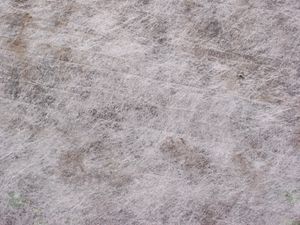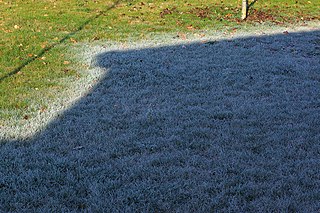
Frost is a thin layer of ice on a solid surface, which forms from water vapor that deposits onto a freezing surface. Frost forms when the air contains more water vapor than it can normally hold at a specific temperature. The process is similar to the formation of dew, except it occurs below the freezing point of water typically without crossing through a liquid state.
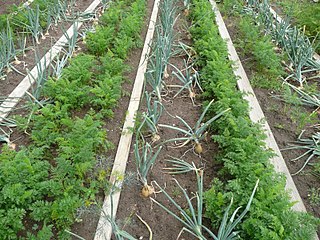
Companion planting in gardening and agriculture is the planting of different crops in proximity for any of a number of different reasons, including weed suppression, pest control, pollination, providing habitat for beneficial insects, maximizing use of space, and to otherwise increase crop productivity. Companion planting is a form of polyculture.
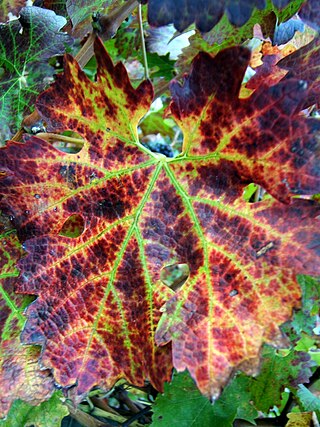
Physiological plant disorders are caused by non-pathological conditions such as poor light, adverse weather, water-logging, phytotoxic compounds or a lack of nutrients, and affect the functioning of the plant system. Physiological disorders are distinguished from plant diseases caused by pathogens, such as a virus or fungus. While the symptoms of physiological disorders may appear disease-like, they can usually be prevented by altering environmental conditions. However, once a plant shows symptoms of a physiological disorder, it is likely that that season's growth or yield will be reduced.
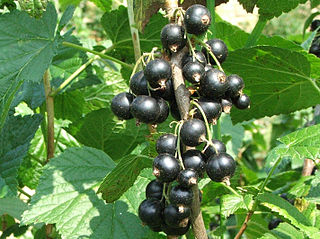
The blackcurrant, also known as black currant or cassis, is a deciduous shrub in the family Grossulariaceae grown for its edible berries. It is native to temperate parts of central and northern Europe and northern Asia, where it prefers damp fertile soils. It is widely cultivated both commercially and domestically.

Horticulture is the cultivation of plants in gardens or greenhouses, as opposed to the field-scale production of crops characteristic of agriculture. It includes the cultivation of fruits, vegetables, nuts, seeds, herbs, sprouts, mushrooms, algae, flowers, seaweeds and non-food crops such as grass and ornamental trees and plants. It also includes plant conservation, landscape restoration, landscape and garden design, construction, and maintenance, and arboriculture, ornamental trees and lawns.

The parsnip is a root vegetable closely related to carrot and parsley, all belonging to the flowering plant family Apiaceae. It is a biennial plant usually grown as an annual. Its long taproot has cream-colored skin and flesh, and, left in the ground to mature, becomes sweeter in flavor after winter frosts. In its first growing season, the plant has a rosette of pinnate, mid-green leaves. If unharvested, it produces a flowering stem topped by an umbel of small yellow flowers in its second growing season, later producing pale brown, flat, winged seeds. By this time, the stem has become woody, and the tap root inedible. Precautions should be taken when handling the stems and foliage, as parsnip sap can cause a skin rash or even blindness if exposed to sunlight after handling.

Intercropping is a multiple cropping practice that involves the cultivation of two or more crops simultaneously on the same field, a form of polyculture. The most common goal of intercropping is to produce a greater yield on a given piece of land by making use of resources or ecological processes that would otherwise not be utilized by a single crop.
Season extension in agriculture is any method that allows a crop to be grown beyond its normal outdoor growing season and harvesting time frame, or the extra time thus achieved. To extend the growing season into the colder months, one can use unheated techniques such as floating row covers, low tunnels, caterpillar tunnels, or hoophouses. However, even if colder temperatures are mitigated, most crops will stop growing when the days become shorter than 10 hours, and resume after winter as the daylight increases above 10 hours. A hothouse — a greenhouse which is heated and illuminated — creates an environment where plants are fooled into thinking it is their normal growing season. Though this is a form of season extension for the grower, it is not the usual meaning of the term.

A polytunnel is a tunnel typically made from steel and covered in polyethylene, usually semi-circular, square or elongated in shape. The interior heats up because incoming solar radiation from the sun warms plants, soil, and other things inside the building faster than heat can escape the structure. Air warmed by the heat from hot interior surfaces is retained in the building by the roof and wall. Temperature, humidity and ventilation can be controlled by equipment fixed in the polytunnel or by manual opening and closing of vents. Polytunnels are mainly used in temperate regions in similar ways to glass greenhouses and row covers. Besides the passive solar heating that every polytunnel provides, every variation of auxiliary heating is represented in current practice. The nesting of row covers and low tunnels inside high tunnels is also common.
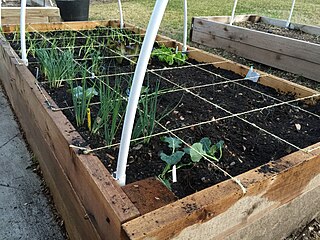
Square foot gardening is the practice of dividing the growing area into small square sections, typically 1 foot (30 cm) on a side, hence the name. The aim is to assist the planning and creating of a small but intensively planted vegetable garden. It results in a simple and orderly gardening system, from which it draws much of its appeal. Mel Bartholomew coined the term "square foot gardening" in his 1981 book of the same name.
Hardiness of plants describes their ability to survive adverse growing conditions. It is usually limited to discussions of climatic adversity. Thus a plant's ability to tolerate cold, heat, drought, flooding, or wind are typically considered measurements of hardiness. Hardiness of plants is defined by their native extent's geographic location: longitude, latitude and elevation. These attributes are often simplified to a hardiness zone. In temperate latitudes, the term most often describes resistance to cold, or "cold-hardiness", and is generally measured by the lowest temperature a plant can withstand.

The tamarillo is a small tree or shrub in the flowering plant family Solanaceae. It is best known as the species that bears the tamarillo, an egg-shaped edible fruit. It is also known as the tree tomato, tomate de árbol, tomate andino, tomate serrano, blood fruit, poor man's tomatoe, tomate de yuca, tomate de españa, sachatomate, berenjena, chilto and tamamoro in South America, tyamtar, rambheda or rukh tamatar in Nepal, and terong Belanda in Indonesia. It is popular globally, especially in Peru, Colombia, New Zealand, Ecuador, Nepal, Rwanda, Burundi, Australia, Bhutan and the United States.

Organic horticulture is the science and art of growing fruits, vegetables, flowers, or ornamental plants by following the essential principles of organic agriculture in soil building and conservation, pest management, and heirloom variety preservation.

In agriculture and gardening, row cover is any transparent or semi-transparent flexible material, like fabric or plastic sheeting, used as a protective covering for plants, usually vegetables. Covers are used to extend growing seasons, and reduce undesirable effects of cold, wind and insects. Row covers can reduce the drying effect of wind, and can provide a small amount of warming in a similar way to unheated cold frames, greenhouses and polytunnels, creating a microclimate for the plants.
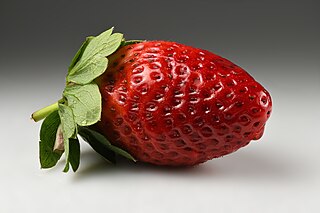
The garden strawberry is a widely grown hybrid species of the genus Fragaria, collectively known as the strawberries, which are cultivated worldwide for their fruit. The fruit is widely appreciated for its characteristic aroma, bright red color, juicy texture, and sweetness. It is consumed in large quantities, either fresh or in such prepared foods as jam, juice, pies, ice cream, milkshakes, and chocolates. Artificial strawberry flavorings and aromas are also widely used in products such as candy, soap, lip gloss, perfume, and many others.
This is an alphabetical index of articles related to gardening.

The carrot fly is a pest of gardens and farms, and mainly affects the crop of carrots, but can also attack parsnips, parsley and celery. It is a member of the family Psilidae.

A beneficial weed is an invasive plant that has some companion plant effect, is edible, contributes to soil health, adds ornamental value, or is otherwise beneficial. These plants are normally not domesticated. However, some invasive plants, such as dandelions, are commercially cultivated, in addition to growing in the wild. Beneficial weeds include many wildflowers, as well as other weeds that are commonly removed or poisoned. Certain weeds that have obnoxious and destructive qualities have been shown to fight illness and are thus used in medicine. For example, Parthenium hysterophorus native to northern Mexico and parts of the US has been an issue for years due to its toxicity and ability to spread rapidly. In the past few decades, though, research has found that P. hysterophorus was "used in traditional medicine to treat inflammation, pain, fever, and diseases like malaria dysentery." It is also known to create biogas that can be used as a bioremediation agent to break down heavy metals and other pollutants.
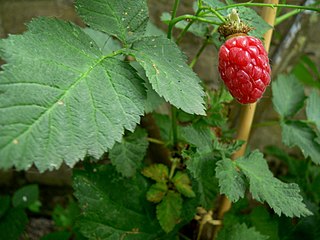
The tayberry is a cultivated shrub in the genus Rubus of the family Rosaceae patented in 1979 as a cross between a blackberry and a red raspberry, and named after the River Tay in Scotland.
Rosemary H. Collier FRES is an entomologist and applied ecologist in the UK. In 2019 she became professor at the University of Warwick.
